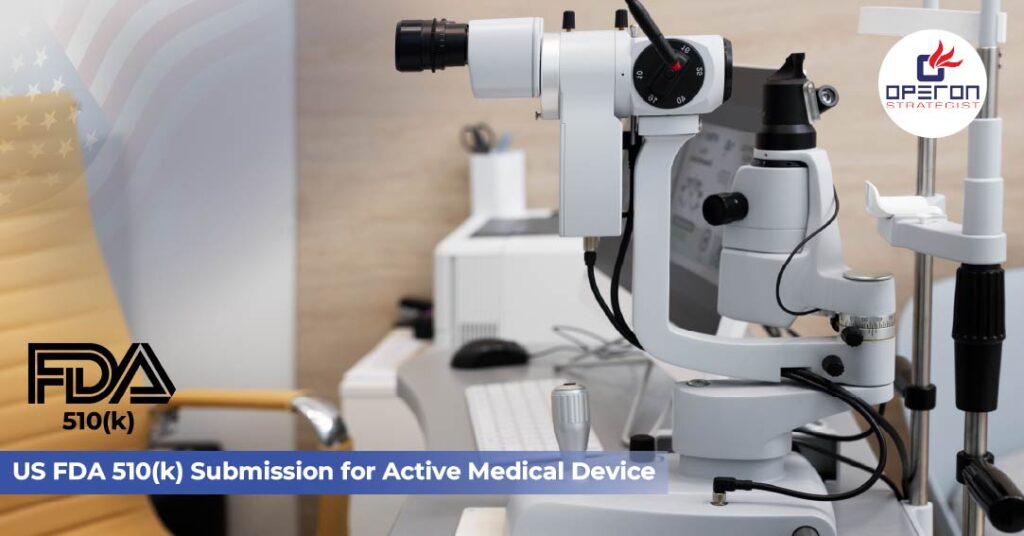Overview: Why Active Devices Need FDA 510(k) Submission
Active medical devices rely on external energy sources and therefore pose moderate risks to patients and users. Because of this, they fall under the regulatory scope of US FDA 510(k) submission. Manufacturers must demonstrate that their product is substantially equivalent to a legally marketed predicate device before it can be sold in the U.S.
In this blog, Operon Strategist provides a step-by-step guide for FDA 510(k) submission for active devices, helping manufacturers achieve compliance efficiently and access the U.S. market faster.
Looking For a Medical Device Regulatory Consultant?
What is an Active Medical Device?
An active medical device is any medical device that relies on an external source of energy—such as electrical, electromagnetic, thermal, or mechanical—to function.
Key Characteristics of Active Devices
- Energy-dependent: Requires batteries, electrical power, or software algorithms.
- Complex functionality: Involves sensors, displays, actuators, or embedded software.
- Examples: Infusion pumps, patient monitors, powered surgical instruments, diagnostic imaging systems (MRI, ultrasound), wearable ECG monitors, or Software as a Medical Device (SaMD).
Regulatory Expectations for Active Devices
Since active devices introduce additional risks—like electrical hazards, software bugs, or electromagnetic interference—the FDA requires:
- Electrical and EMC safety testing (IEC 60601)
- Software validation and cybersecurity control
- Risk management as per ISO 14971
- Clear labeling and user instructions
These requirements ensure that active devices are safe, effective, and perform as intended throughout their lifecycle.
Understanding the FDA 510(k) Submission
The FDA 510(k) premarket notification is a mandatory submission process that allows a manufacturer to market a medical device in the United States. The manufacturer must demonstrate that the new device is substantially equivalent in safety and effectiveness to a legally marketed predicate device.
Why Active Devices Require 510(k) Submission
Active medical devices typically fall under Class II, indicating moderate risk. These devices require 510(k) clearance for the following reasons:
- Moderate risk profile: Class II devices require regulatory oversight to ensure performance safety.
- Energy-driven operation: Electrical, software, or battery-operated devices introduce potential risks like shocks or software malfunctions.
- Substantial equivalence demonstration: Manufacturers can avoid clinical trials by proving that their device has the same intended use and similar technology to a predicate device.
- Legal market access: Without 510(k) clearance, active devices cannot be legally sold in the U.S.
Types of FDA 510(k) Submissions
- Traditional 510(k):
Required for new devices. Includes full documentation and testing data.
- Abbreviated 510(k):
Based on recognized FDA consensus standards and guidance documents.
- Special 510(k):
Used for modifications to an existing device where technology and intended use remain unchanged.
Key Requirements for FDA 510(k) Submission for Active Devices
- Device Description: Detailed explanation of design, components, power source, and operation.
- Indications for Use: Clear statement of intended medical use and target user population.
- Predicate Comparison: In-depth comparison of the new device with predicate devices, highlighting similarities and differences.
- Performance Testing: Electrical safety, EMC, battery performance, sterilization, and durability testing.
- Software Documentation: Verification, validation, cybersecurity controls (IEC 62304 compliance).
- Biocompatibility: Evidence or rationale for patient-contact materials.
- Risk Management: ISO 14971-based analysis with mitigations linked to design controls.
- Labeling and IFU: Accurate labeling, warnings, and instructions to prevent misuse.
- QMS Evidence: Quality Management System (ISO 13485) compliance overview and reference to Design History File (DHF).
Step-by-Step Phases of 510(k) Submission for Active Devices
Phase 1: Device Definition
- Define intended use and product code
- Draft indications for use (Form 3881)
- Identify and justify predicate device
- Prepare device description and summary
Phase 2: Design & Testing
- Compile design files, flowcharts, and labeling
- Conduct bench testing, EMC, and electrical safety testing
- Perform risk management and prepare ISO 14971 report
- Document compliance with relevant consensus standards
Phase 3: Substantial Equivalence
- Complete Form 3514 and executive summary
- Provide comparative analysis with predicate device
- Summarize substantial equivalence discussion
Phase 4: Administrative Documentation
- Prepare cover letter, truthful & accuracy statement, and declarations of conformity
- Fill FDA Form 3601 (user fee cover sheet)
Phase 5: Final Submission
- Complete Refuse-to-Accept (RTA) checklist
- Compile e-copy and submit to the FDA
Common Pitfalls to Avoid in 510(k) Submissions
- Weak Predicate Selection: Mismatch in intended use or technology.
- Incomplete Documentation: Missing test reports or inconsistent sections.
- Insufficient Testing: Inadequate IEC 60601 or EMC validation.
- Poor Software Documentation: Missing architecture or cybersecurity details.
- Ignoring the RTA Checklist: Leads to immediate hold or rejection.
- Delayed Communication: Late responses to FDA queries extend review timelines.
Expert Guidance for Your FDA 510(k) Submission
Navigating the FDA 510(k) submission for active medical devices can be complex and time-consuming. Operon Strategist offers end-to-end regulatory support for manufacturers—covering documentation, testing guidance, risk analysis, and submission review.
Our team ensures that your active medical device meets US FDA standards and is ready for successful market entry.
Contact us today to streamline your FDA 510(k) submission process.
- adminhttps://operonstrategist.com/author/admin-2/
- adminhttps://operonstrategist.com/author/admin-2/
- adminhttps://operonstrategist.com/author/admin-2/
- adminhttps://operonstrategist.com/author/admin-2/




